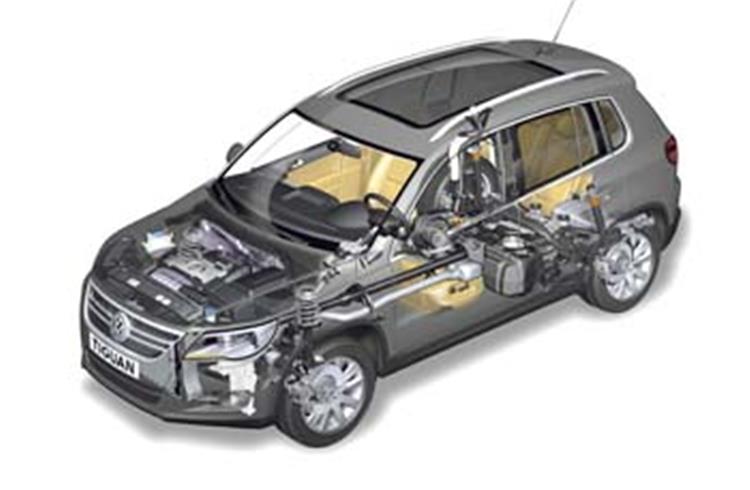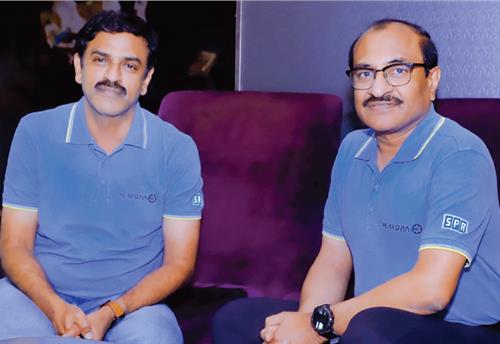Industry opts for plastics
These indeed are tough times and the ongoing global recession has automobile manufacturers worried as did the spike in oil prices earlier this year. And most of them are going back to the drawing board in quest of alternative materials.
The use of automotive plastic to reduce weight is now a global trend and several automakers have already initiated replacement of metal components with plastic. This practice is now catching up in India.
The Reva, India’s first electric vehicle designed for low speed, congested, and urban conditions, recognised the benefits of using plastic. Its body is made of hard ABS (acrylonitrilebutadiene-styrene) plastic and a tubular spaceframe that holds things together. In fact the ABS is practical for biffs and bags which means that if you hammer the body with a mallet, it will bounce back in shape. ABS plastic body panels also mean a rust-free car and easy, cheap accident repair or panel replacement too.
Automotive Plastics India 2008: Revolution in Plastic, a recent seminar in Mumbai organised by the All India Plastic Manufacturers Association (AIPMA), saw industry experts speak about the burgeoning demand for engineering plastic for use in several areas like car interiors, body panels or structural components. The seminar also focused on the use of raw material and the need for increased communication between vehicle manufacturers and suppliers, IT, researchers and key industry associations. Autocar Professional was the media partner at the event.
Burgeoning demand
With significant parts of the world economy being recession-hit, Indian auto companies dealing in automotive plastics are optimistic that demand for their products will grow substantially. The Indian polymer industry, which will account for nine percent of global polymer demand by 2015, is expected to maintain a 15 percent growth rate annually, which is twice the GDP growth. The country is set to be the third largest polymer consumer by 2010 and will overtake Germany, Japan, South Korea, Italy, France, UK and Brazil. An additional two million tonnes of polymers will be manufactured in India by 2010. Exports too are growing at around 21 percent annually.
According to Kailash B Murarka, president, AIPMA, who made the keynote address, India has been showing handsome growth in the recent past. He said, “India’s polymer consumption has grown from 1.6 million metric tonnes (MMT) in 1988 to 3.3 MMT in 2000. The projection for 2010 stands at 12.3 MMTs. India, projected to be the third largest consumer of plastics in the world by 2010, is expected to cross the total consumption of polymers for plastic in India in 2008-09 by 6.5 million tonnes.”
Murarka added, “The per capita consumption of plastics in a single car is around five kilograms as compared to the world average of 26 kilograms. This is set to double to around 10kg by 2012.”
A car on an average consumes about 60-130kg of plastic. Globally, the plastic usage in cars has been steadily rising since the 1950s and the average weight of a car fell by more than 15 percent between 1973 (when the cost of oil became a first major factor in automotive design) and the end of the 1980s. Cost consciousness highlighted the advantages of plastics component consolidation and simplified assembly.
The past few years have seen several advances in plastics technology and a number of conventional metal parts like fuel tanks have been replicated in plastic. In India too, automakers are asking their component suppliers to think plastic mainly to reduce weight, which in turn contributes to improved fuel efficiency. Recognising a business opportunity in the growing market, international majors like BASF, Bayer, Du Pont and Dow Corning have set up shop in India.
Plastics increasingly are also making their presence felt in vehicle design and engineering. Mirisch Damani, managing director, Zylog Plastalloys, says: “Plastics have revolutionised interior and exterior automotive design. They allow engineers greater flexibility in styling, building, and assembling components as well as combine several complex parts into a single integrated component, while lowering manufacturing costs. New technology and processes enable use of recycled materials, making it highly cost effective. Today there is burgeoning demand for a wide variety of plastics such as modified polypropylene, ABS, PC, PC+ABS, PC+PBT, modified PPE and SMA resins that are used to manufacture various parts and components for automotive interiors, exteriors and under-the-hood applications.”
According to Damani, there will be significant growth in plastic usage by the Indian automotive industry. Indian cars, regardless of the segment, are increasingly seeing new levels of luxury inside the cabin that are often a result of using plastic in different forms.
The Tata Nano is a prime example of how Indian carmakers are using plastics to bring down costs and weight. Tata Motors is known to have extensively worked with General Electric’s plastics division to develop solutions for its ultra-low cost small car. Luxury carmakers too are taking the plastic route. Says Amer Hussain, manager – S.E. Interior Materials, Bentley Motors: “The number of plastic parts going into a car will grow constantly and this growth will come from both the luxury and the other cars.”
Which plastic?
Plastics have commodity and engineering application through compounds like Polypropylene (PP), Polyethylene (PE), Polyamides and Polyacetal. According to experts, low density compounds have the capability to reduce coefficient of linear thermal expansion, improve scratch and mar resistance, higher flow material with excellent impact / stiffness balance, and improved control of crystallanity/ paintability/ decorative capability.
Damani adds, “Polypropylene, due to its versatility in technology and price, will outpace the growth rate among other thermoplastics in the automotive sector. Polypropylene consumption in an average passenger car globally exceeds 70kg per vehicle, which is over 50 percent of total plastics consumed.”
Typical interior plastic components include the dashboard, console, door and pillar trim, sun visor, steering wheel, grab handles, mirrors, headlining and the parcel shelf. Current global technology trends for automotive interiors include several processes of multi-component molding, in-line moulding, interior semi-structural substitutions, increased use of single compound for multiple interior and exterior components, continued substitution for thermoset rubbers, lighting innovation and plastic glazing effects.
The typical exterior and chassis-mounted plastic components are used in areas such as the fuel lines, bumpers and grilles, outer handles, mirrors, headlamps, taillamps, spoiler, brakelines, foot step, wheel liners, and mud flaps. Plastic components also find their way under the bonnet include the cylinder head cover, pulley cover, engine cover, containers for fluids, battery intake manifold, fuel rail, radiator fans and tanks, and the timing belt cover.
Eckart Hermann, Group Laboratory Polymers, Interior, Volkswagen, too believes polypropylene is the compound in demand. He says, “The amount of polypropylene being used in car interiors is constantly increasing. More and more applications are being realised with polypropylene. An improved cooperation between PP producers, Tier-1 and OEMs will result in an ability to evaluate and resolve material-related issues in a very early design phase of an application.”
According to Gangadhar Nadgouda, deputy general manager (ADD & Materials – CVBU), Tata Motors, says: “Demand is looking up for high-end polymers which withstand high temperature and pressure conditions.” Plastics have limitations and challenges as well. Consumer expectations are ever evolving for cars that perform better, provide more features, and cost less. Thus it is essential to meet product timelines for the development of the component. There are also limitations on development of tailor-made grades to meet Indian market performance targets.
Cutting metal in cars
Reducing their dependence on metals to some extent is what leading players like Tata Motors, Bajaj Auto, Ashok Leyland, Hero Honda, TVS Motor and Maruti Suzuki are attempting and even augmenting the use of plastics in engine components. Increased use of plastic components can reduce the overall weight of a car by as much as 40 percent, which can go a long way in improving fuel efficiency. In addition, the cost of tooling plastic is half that of a conventional metal-based tooling system.
According to Dr Arun K Jaura, chief technology officer, Mahindra & Mahindra (M&M), “The use of plastics in automobiles in India is still much less than that of some of the international markets. There is a lot of scope for development in this space. Modern-day plastics are durable and flexible and M&M is constantly increasing focus on the product.”
Clearly, the writing is on the wall as far as the automotive industry is concerned. Vehicle manufacturers and component suppliers are constantly looking at newer ways of using polymer-based metal substitutes.
RELATED ARTICLES
BRANDED CONTENT: Eliminating the worries of battery charging with smart solutions
The charging infrastructure is the backbone of electric mobility but is also one of the key perceived barriers to EV ado...
The battery-powered disruptor
Greenfuel Energy Solutions is planning to shake up the EV battery market with the launch of a portfolio of specially eng...
SPR Engenious drives diversification at Shriram Pistons & Rings
The engine component maker is now expanding its business with the manufacturing of motors and controllers through its wh...





 By Autocar Pro News Desk
By Autocar Pro News Desk
 05 Dec 2008
05 Dec 2008
 4989 Views
4989 Views









